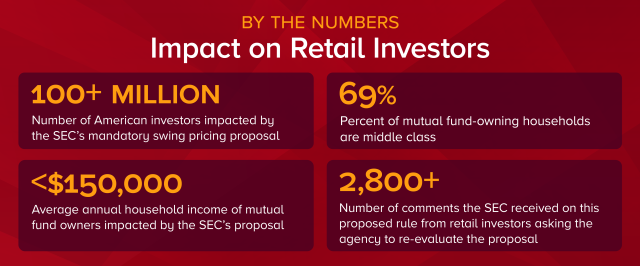The SEC has proposed a rule that threatens mutual funds and will harm middle-class families trying to build financial security.
The proposal requires mutual funds to impose a “hard close” cut-off time on when investors can buy and sell their funds, meaning that millions of American investors will not get the best price for their trades.
It also creates operational challenges for mutual funds that could risk depriving Americans of access to funds and investment strategies they rely on to reach financial goals such as retirement, buying a home, or paying for college.

Key Policy Issues
Adoption of this proposal would fundamentally alter the management, operation, and pricing of mutual funds, as well as how investors purchase and sell their shares. Among other things, the proposal requires mutual funds to adopt mandatory swing pricing and impose a “hard close” cut-off time on when investors can buy and sell their funds. The proposal also would impose new liquidity risk management requirements on both mutual funds and ETFs.
Mandatory Swing Pricing
"Swing pricing" is when a fund artificially changes the net asset value of the fund on any given day that flows in or out of a fund are deemed to be too great.
- Currently, US mutual funds have the option to implement swing pricing to assure that transacting shareholders bear the trading costs associated with their transactions.
- The fund does this by adjusting—or swinging—the price above or below a fund’s NAV per share.
- Swing pricing is used in Europe, but it’s not an apt comparison. The shareholder characteristics, distribution arrangements, and investment products in Europe are different.
- Moreover, it is optional for use as appropriate, at the discretion of the investment manager.
- In contrast, the SEC’s proposal would mandate swing pricing in the US, leaving the investment manager with no discretion. This would impose unnecessary and significant costs with little evidence of the need for such a sweeping transformation.
- Key Takeaway: While swing pricing can be a useful tool under certain circumstances, the SEC’s proposal is a one-size-fits-all approach that doesn’t consider a fund’s structure and objectives.
Hard Close
The SEC’s proposal mandates a “hard close,” which is a cut-off time when orders can no longer be executed at today’s price.
- Currently, if an investor submits an order to an intermediary, such as a broker-dealer, or a retirement recordkeeper to purchase or redeem fund shares before 4 p.m. ET, that order will be executed at the current day’s price. The fund, however, generally does not receive the order until later, sometimes several hours later.
- The SEC’s “hard close” would mean that intermediaries and recordkeepers may have to implement a cut-off time as early as 10 a.m. ET, meaning that any order received after that time can no longer be executed at today’s price, and would instead receive tomorrow’s price.
- Key Takeaway: This proposal would mean that middle class American investors, including anyone in a retirement plan, would be at a major disadvantage compared to other market participants, as these investors would not be able to make trades in response to timely market events or evaluate important market-related information announced later in the day. West Coast investors would be at a permanent disadvantage as the cut-off time for the day’s trading would likely be before they have even gotten out of bed.
Liquidity Management
Currently, in accordance with SEC rules implemented in 2016, funds must have a written liquidity risk management program.
- To do this, they must classify each portfolio investment into one of four liquidity “buckets” and maintain a minimum amount of its portfolio in “highly liquid investments.”
- The new SEC proposal would arbitrarily change those amounts based on an unproven theory that open-end funds contributed to sudden changes in market liquidity in March 2020.
- By any measure, funds have managed liquidity and met redemptions successfully while pursuing their investment objectives and strategies.
- Key Takeaway: Funds routinely meet large volumes of shareholder redemptions each year without incident. The SEC’s proposal is arbitrary, with a flawed economic analysis
Seeking a Sensible Approach
None of the proposed liquidity risk management, swing pricing, or hard close amendments appear to be the product of a deliberate and evidence-based process. Any comprehensive and objective review of funds’ 80+ year track record of managing liquidity suggests incremental change is the way to best serve the interests of fund shareholders.
The SEC should do far more investigation and public consultation to allow interested parties to share their expertise and perspectives. With far more information and analysis, the Commission then could consider actions related to the fund industry’s current liquidity risk management processes. These actions would produce much more thoughtful and constructive information. A deliberate process that explores these matters with the depth and care that they deserve would better serve fund investors.

